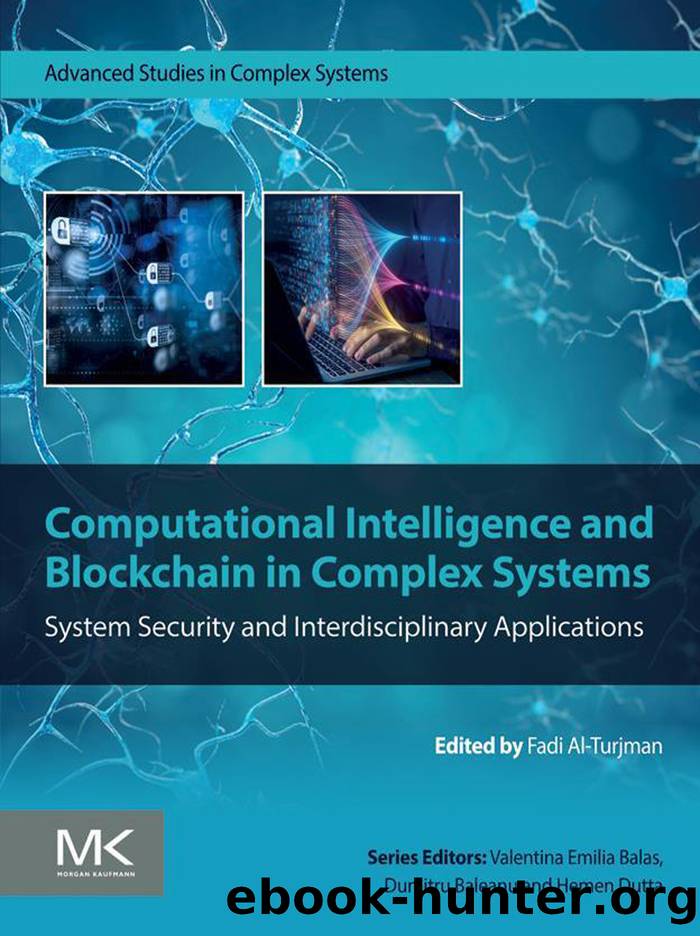Computational Intelligence and Blockchain in Complex Systems by Unknown

Author:Unknown
Language: eng
Format: epub
ISBN: 9780443132742
Publisher: Elsevier Inc.
Published: 2024-03-15T00:00:00+00:00
References
1. American Psychiatric Association (APA), Diagnostic and Statistical Manual of Mental Disorders, fifth ed. <https://doi.org/10.1176/appi.books.9780890425596>, 2013.
2. Wilens TE, Spencer TJ. Understanding attention-deficit/hyperactivity disorder from childhood to adulthood. Postgrad Med. 2010;122(5):97â109 https://doi.org/10.3810/pgm.2010.09.2206.
3. Harpin VA. The effect of ADHD on the life of an individual, their family, and community from preschool to adult life. Arch Dis Child. 2005;90(1):2â7 https://doi.org/10.1136/adc.2004.059006.
4. Aase H, Meyer A, Sagvolden T. Moment-to-moment dynamics of ADHD behaviour in South African children. Behav Brain Funct. 2006;2(1):1â13 https://doi.org/10.1186/1744-9081-2-11.
5. Cabral MDI, Liu S, Soares N. Attention-deficit/hyperactivity disorder: diagnostic criteria, epidemiology, risk factors and evaluation in youth. Transl Pediatrics. 2020;9(1):104â113 https://doi.org/10.21037/tp.2019.09.08.
6. Rigoni M, Blevins LZ, Rettew DC, Kasehagen L. Symptom level associations between attention-deficit hyperactivity disorder and school performance. Clin Pediatrics. 2020;59(9â10):874â884 https://doi.org/10.1177/0009922820924692.
7. Antshel KM, Hargrave TM, Simonescu M, Kaul P, Hendricks K, Faraone SV. Advances in understanding and treating ADHD. BMC Med. 2011;9(1):1â12 https://doi.org/10.1186/1741-7015-9-72.
8. Lambez B, Harwood A, Golumbic EZ, Rassovsky Y. Non-pharmacological interventions for cognitive difficulties in ADHD: a systematic review and meta-analysis. J Psychiatr Res. 2020;120:40â55 https://doi.org/10.1016/j.jpsychires.2019.10.007.
9. Bodnar M. Teaching English to young learners with ADHD and dyslexia. World Sci N. 2015;8:37â53 http://www.worldscientificnews.com in 11 February 2023.
10. DuPaul GJ, McGoey KE, Eckert TL. Preschool children with attention deficit/hyperactivity disorder impairments in behavioural, social, and school functioning. J Am Acad Child Adolesc Psych. 2001;40(5):508â515 https://doi.org/10.1097/00004583-200105000-00009.
11. H. Meltzer, R. Gatward, R. Goodman, The Mental Health of Child Renandadole Scents in Great Britain, London, 2000.
12. Mannuzza S, Klein RG, Bessler A. Adult outcome of hyperactive boys: educational achievement, occupational rank and psychiatric status. Arch Gen Psych. 1993;50:565â576 https://doi.org/10.1001/archpsyc.1993.01820190067007.
13. I. Anju, Effectiveness of problem-based learning in developing cognitive skills in physics among students with attention deficit hyperactivity disorder at secondary school level, Ph.D. Thesis, University of Calicut, Kerala, 2014.
14. Loe IM, Feldman HM. Academic and educational outcomes of children with ADHD. J Pediatric Psychol. 2007;32(6):643â654 https://doi.org/10.1093/jpepsy/jsl054.
15. Swanson JM, McBurnett K, Christian DL, Wigal T. Stimulant medication and treatment of children with ADHD. In: New York: Plenum Press; 1995;:265â322. Ollendick TH, Prinz RJ, eds. Advances in Clinical Child Psychology. Vol. 17.
16. Evans SW, Pelham WE, Smith BH. Dose-response effects of methylphenidate on ecologically valid measures of academic performance and classroom behaviour in adolescents with ADHD. Exp Clin Psychopharmacol. 2001;9(2):163â175 https://doi.org/10.1037/1064-1297.9.2.163.
17. Howland J, Jonassen D, Marra R, Moore J. Learning to Solve Problems with Technology: A Constructivist Perspective 2nd ed. Pearson 2003;.
18. Agapito LG. Leading the 21st century ICT-based school in the changing paradigm in education: challenges and steps forward. Psychol Educ J. 2021;58(2):10338â10359 https://doi.org/10.17762/pae.v58i2.4005.
19. Jonassen D, Howland J, Moore J, Mara R. Learning to Solve Problems with Technology A Constructivist Perspective Merrill: Prentice Hall; 2003;.
20. Van der Veer A, Alsmith A, Longo M, Wong H, Mohler B. Where am I in virtual reality. PLoS One. 2018;13(10):1â10 https://doi.org/10.1371/journal.pone.0204358.
21. Alsmith A, Longo M. Where exactly am I? Self-location judgments distribute between the head and torso. Conscious Cognition. 2014;24:70â74 https://doi.org/10.1016/j.concog.2013.12.005.
22. Starmans C, Bloom P. Windows to the soul: children and adults see the eyes as the location of the self. Cognition. 2012;123(2):313â318 https://doi.org/10.1016/j.cognition.2012.02.002.
23. Vergara D, Extremera J, Rubio MP, Davila L.
Download
This site does not store any files on its server. We only index and link to content provided by other sites. Please contact the content providers to delete copyright contents if any and email us, we'll remove relevant links or contents immediately.
Deep Learning with Python by François Chollet(14777)
The Mikado Method by Ola Ellnestam Daniel Brolund(12037)
Hello! Python by Anthony Briggs(11948)
OCA Java SE 8 Programmer I Certification Guide by Mala Gupta(11367)
Dependency Injection in .NET by Mark Seemann(11134)
A Developer's Guide to Building Resilient Cloud Applications with Azure by Hamida Rebai Trabelsi(10527)
Algorithms of the Intelligent Web by Haralambos Marmanis;Dmitry Babenko(9965)
The Well-Grounded Java Developer by Benjamin J. Evans Martijn Verburg(9572)
Grails in Action by Glen Smith Peter Ledbrook(9291)
Hit Refresh by Satya Nadella(9039)
Sass and Compass in Action by Wynn Netherland Nathan Weizenbaum Chris Eppstein Brandon Mathis(8892)
Secrets of the JavaScript Ninja by John Resig Bear Bibeault(8758)
The Kubernetes Operator Framework Book by Michael Dame(8473)
Test-Driven iOS Development with Swift 4 by Dominik Hauser(8359)
Exploring Deepfakes by Bryan Lyon and Matt Tora(8294)
Robo-Advisor with Python by Aki Ranin(8247)
Practical Computer Architecture with Python and ARM by Alan Clements(8222)
Implementing Enterprise Observability for Success by Manisha Agrawal and Karun Krishnannair(8192)
Building Low Latency Applications with C++ by Sourav Ghosh(8096)
